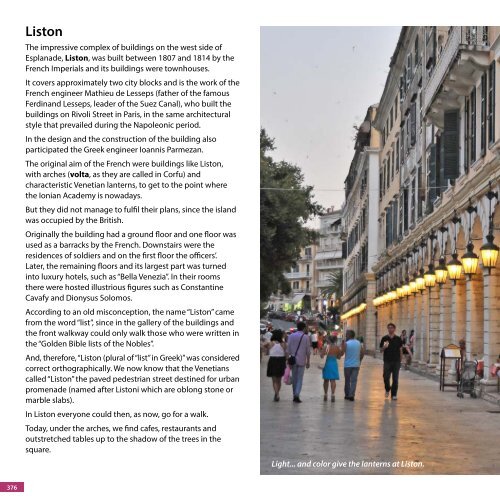Create successful ePaper yourself
Turn your PDF publications into a flip-book with our unique Google optimized e-Paper software.
Liston<br />
The impressive complex of buildings on the west side of<br />
Esplanade, Liston, was built between 1807 and 1814 by the<br />
French Imperials and its buildings were townhouses.<br />
It covers approximately two city blocks and is the work of the<br />
French engineer Mathieu de Lesseps (father of the famous<br />
Ferdinand Lesseps, leader of the Suez Canal), who built the<br />
buildings on Rivoli Street in Paris, in the same architectural<br />
style that prevailed during the Napoleonic period.<br />
In the design and the construction of the building also<br />
participated the Greek engineer Ioannis Parmezan.<br />
The original aim of the French were buildings like Liston,<br />
with arches (volta, as they are called in Corfu) and<br />
characteristic Venetian lanterns, to get to the point where<br />
the Ionian Academy is nowadays.<br />
But they did not manage to fulfil their plans, since the island<br />
was occupied by the British.<br />
Originally the building had a ground floor and one floor was<br />
used as a barracks by the French. Downstairs were the<br />
residences of soldiers and on the first floor the officers’.<br />
Later, the remaining floors and its largest part was turned<br />
into luxury hotels, such as “Bella Venezia”. In their rooms<br />
there were hosted illustrious figures such as Constantine<br />
Cavafy and Dionysus Solomos.<br />
According to an old misconception, the name “Liston” came<br />
from the word “list”, since in the gallery of the buildings and<br />
the front walkway could only walk those who were written in<br />
the “Golden Bible lists of the Nobles”.<br />
And, therefore, “Liston (plural of “list” in Greek)” was considered<br />
correct orthographically. We now know that the Venetians<br />
called “Liston” the paved pedestrian street destined for urban<br />
promenade (named after Listoni which are oblong stone or<br />
marble slabs).<br />
In Liston everyone could then, as now, go for a walk.<br />
Today, under the arches, we find cafes, restaurants and<br />
outstretched tables up to the shadow of the trees in the<br />
square.<br />
Light... and color give the lanterns at Liston.<br />
376



